DEL MAR, Calif. — A man named Everett Rogers came up with something called the Diffusion of Innovations theory in 1962. Don’t worry, I’ll keep this short. It outlined five stages that innovative new products typically move through, and when it comes to electric vehicles, we’re still in the second stage: Early Adopters. Generally speaking, electric cars for them have needed to stand out in terms of design and branding. Different is a must, weird is OK. For EV adoption to move into the next, “Early Majority” stage, risks have to be minimized, familiarity is important and practicality made paramount.
The 2025 Chevrolet Blazer EV is basically intended to spark that Early Majority. It’s boldly styled, sure, but not in a way that’s foreign or overly futuristic. It mostly looks like the next generation of the existing, gas-powered Chevy Blazer (and clearly related to the similarly gas-only Chevy Trax). The interior may be rocking a gigantic screen, but there are still buttons and a tall center console with bins aplenty. The core of the lineup comes standard with front-wheel drive and offers all-wheel drive as an option for poor-weather traction – just like the existing Blazer and most other crossovers. Heck, even using the name Blazer speaks to the goal of familiarity.
Importantly, it’s not dull. It looks great inside and out, and while it may not be as sporty to drive as some might infer by those looks, its suspension, steering and throttle response are tuned consistently with Chevrolet’s dynamic renaissance that’s attempted to make its core products consistent in character with its halo ones, the Corvette and Camaro. It’s no different than Mazda SUVs feeling related to the Miata or four-door Porsches to the 911. To “drive like a Chevrolet” means something now, and it’s very much a positive. That the Blazer EV achieves that dynamic cohesion despite its electric platform is commendable.

The hurdles regarding charging and cost are still there – home charging will remain impossible for some, public fast charging will remain a crap shoot for all, and the Blazer EV costs considerably more than the surviving (for now) gas-powered Blazer. Groups four and five in the innovation adoption theory, “Late Majority” and “Laggards,” still aren’t signing up. Yet, it’s much easier to see the Blazer EV piquing the interest of those who have thus far found EVs too alien.
To dive deeper into the Blazer EV story, it’s important to start with its Ultium EV platform. Blazer is the first mainstream Ultium product, following the Hummer EV and Cadillac Lyriq, with the Chevy Equinox EV to follow in the short term (along with the Honda Prologue and Acura ZDX, long story). Think of Ultium as the Lego-ification of car building. Battery modules that are roughly the size of a fat briefcase can be added or subtracted based on range, performance and packaging requirements. Motor units of differing output and type can also be mixed and matched to satisfy differing goals. That attribute is fully on display in the Blazer EV – uniquely, it can be front-, rear- or all-wheel drive.
The LT trim levels come standard with an approximately 241-horsepower permanent magnet motor that powers the front axle (official horsepower and torque figures are yet to be announced). Optional on the LT and standard on the RS is a small, 90-horsepower induction motor added to the rear axle (you can read about the differences in motor types here) for a combined 288 horsepower and 333 pound-feet of torque, but the resulting all-wheel drive system is much different than the usual “dual-motor” all-wheel-drive EVs that have motors of the same type, a more similar output on each axle and therefore a considerable performance bump. GM engineer Patrick Lencioni explained that the Blazer’s rear motor really only responds to front-wheel slippage or to aid traction when accelerating – in this way, it’s more like an all-wheel-drive Toyota hybrid. This functionality is also comparable to most conventional, mechanical all-wheel-drive systems.
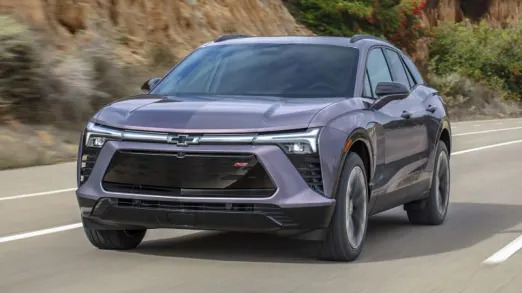
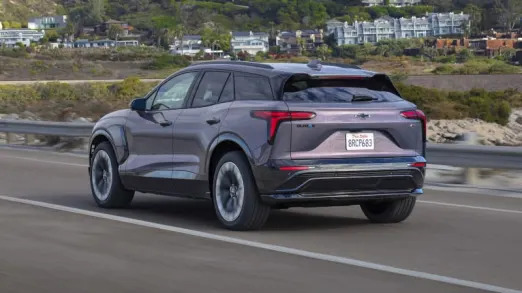
This is a smart, consumer-friendly approach for the mainstream market. Most of the Blazer EV’s competitors are rear-wheel-drive as standard, which is not ideal for those living in colder climates. For many customers, that means selecting all-wheel drive, but unlike the $1,500 or $2,000 AWD upcharge for gas-powered cars, you’re looking at two or three times that since the added traction also comes with that considerable performance bump. With the Blazer, customers are fine to stick with front-wheel drive for winter driving or should at least face a much smaller AWD upcharge (exact pricing has not been confirmed).
Most of our seat time happened in an all-wheel-drive RS. Its 288 horsepower and 333 pound-feet of torque does indeed fall short of other dual-motor EVs, and not surprisingly, its acceleration falls short as well. It doesn’t provide that “EV smack,” partly because it doesn’t have the guts to do so, but also because GM smartly tuned the throttle to ease into the available torque in a more civilized, natural manner. This also prevents torque steer. All that said, the Blazer EV e-AWD offers far more compelling performance, not to mention being quieter and smoother, than the current Blazer’s turbo-four and V6 engine options.
Here is where things get weird, though. The RS is available with rear-wheel drive courtesy of a totally different 250-kW motor that produces 340 hp and 325 lb-ft of torque. It also gets more of those battery modules, for a total capacity of 102 kWh versus 85, to achieve the best-possible range of 324 miles. The e-AWD versions will go a maximum of 279 miles. Although there is certainly a performance advantage with the rear-drive Blazer, it doesn’t radically transform the driving experience. Get visions of doughnuts in the parking lot out of your head. Instead, chief engineer Marisa Cullen says that the purpose of the rear-drive RS was to clear the 300-mile threshold that market research shows is a mental hurdle for those reluctant to make the jump to EVs. It’s also a nice bonus choice for those in warm weather climates.

Unfortunately, Chevrolet has only announced prices for the rear-wheel-drive RS ($58,595, including destination) and the all-wheel-drive 2 LT ($53,195), so the full value proposition of this trim level and powertrain lineup is still TBD. The Blazer EV’s marketing director, Brad Franz, did say “we’re well positioned for the 2024 (federal EV) tax credit,” referring to the fact that even some American-made EVs will no longer qualify due to materials sourcing requirements.
Now, for those who do want a substantial performance increase, the range-topping Blazer EV SS arriving later next year is a proper dual-motor EV, with one of those 250-kW motors on each axle. That’ll be good for 557 hp and 648 lb-ft of torque. We didn’t get a chance to drive the SS, nor did we sample the front-drive LT on the other end of the spectrum.
Recharging capability depends on battery. The 85-kWh pack is capable of a max DC fast charging speed of 150 kW (recoups 69 miles in 10 minutes), while the 102-kWh pack can max out at 190 kW (78 miles in 10 minutes). These are sufficient speeds, but Hyundai/Kia blitzes them by a considerable margin. Both Blazer batteries are capable of pulling 11 kW from AC home charging – you’d need a home charger to achieve that, but it’s pretty much the industry norm at the moment. You will also be able to send power back to your house, thereby making the Blazer EV a battery backup, but it requires additional GM Energy products.
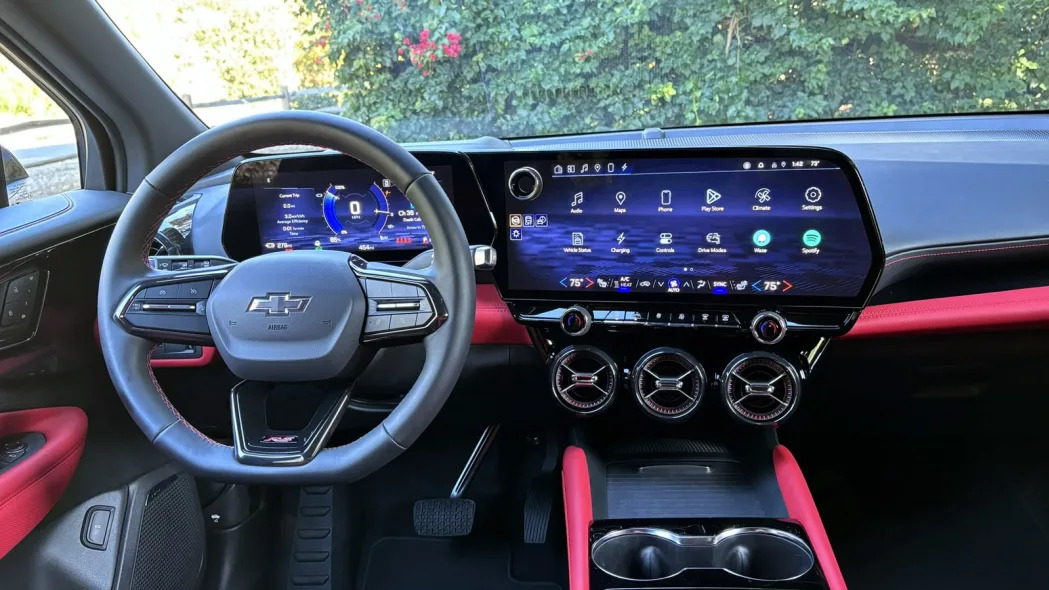
The interior is free from gimmicks or weirdness to impress the friends of early adopters. Pennies haven’t been pinched by removing buttons or adopting a stripped-down, minimalist look. On the contrary, the Blazer EV probably has the nicest interior Chevrolet has ever created. Although getting an RS and its stunning red simulated leather is certainly its best foot forward, the overall materials and build quality are excellent, the switchgear is top-notch (including new pieces to the GM parts bin), and the big, vibrant screens are beautifully integrated rather than bolted-on tablets. I couldn’t help but think that the Mustang Mach-E is not going to fare well when cross-shopped.
Importantly, everything works. The Android-based infotainment system is incredibly easy to figure out and to use, with permanently docked menu shortcuts atop the 17.7-inch touchscreen that are within a short reach from the steering wheel. Navigation is provided by Google Maps with increased capability beyond the usual Apple CarPlay/Android Auto app, including the ability for its map to be one of several layout options in the configurable 11-inch instrument panel. The full Google-Built-In suite is on board, too, including integrated Spotify, Audible and Waze apps plus a variety of others in the Google Play store. While this mostly renders Android Auto a moot point, Apple CarPlay could still be of use to many, and neither smartphone integration features are present. The Blazer EV is the first GM new vehicle to walk away from these now-expected features, and it’s hard to see why it’s a plus. But GM has a new explanation.
A bevy of driver assistance safety features are at least present, with adaptive cruise control available within a larger package and Super Cruise available as a stand-alone option.
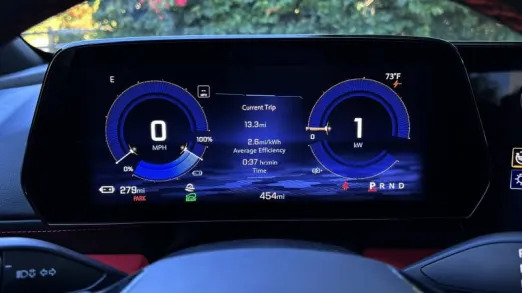

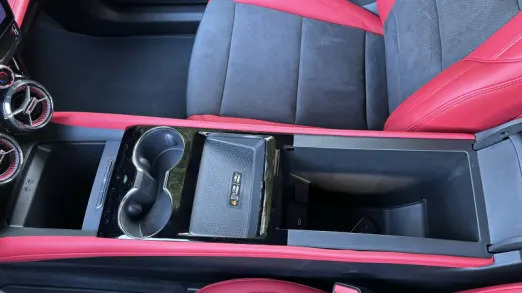
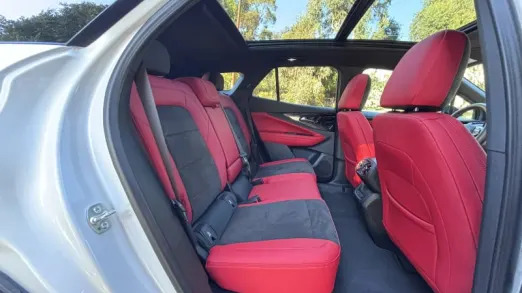
Although many EVs have open spaces between the front footwells or novel center console functionality, the Blazer is purposely old school. Why? People have gotten used to and actually like a regular flip-up armrest with a bin underneath, some generously sized cupholders and an overall height that’s on the high side. There’s also a wireless phone charger, a second shallow phone tray and a deep bin forward of the cupholders. The electronic shifter, which is a column-mounted stalk, will be foreign to current GM owners and many others, but it’s straightforward, and basically what Mercedes has been using for years. Tesla did, too, before opting for a touchscreen-based shifter.
In terms of space, the Blazer EV’s vast wheelbase affords it an immense amount of back seat legroom. The available panoramic sunroof, on the other hand, robs it of considerable headroom. I wouldn’t check that box. Chevrolet did not provide a cargo capacity figure, but to my trained eye, I doubt it’s more than 30 cubic feet of space. The area is long and wide, but the height is minimal, and unlike the Equinox EV, there isn’t a dual-level floor to increase capacity. There is a deep well underneath the floor, but it’s best suited to grocery bags.
Another potential shortfall is the ride quality of the RS trim level and its 21-inch wheels. It’s on the firm side, and it results in a fair bit of head bobbing on certain types of pavement. Big bumps are dispatched well, but there wasn’t an LT available to drive to see how much a difference its 19-inch wheels make besides looking worse.
Indeed, the RS looks fantastic, especially in our test car’s metallic candy apple red. The Blazer EV may be pretty normal for an EV, but for a midsize SUV, it’ll stand out in the best possible way. If the Bolt had looked this good, we might’ve been further along that EV adoption curve by now.
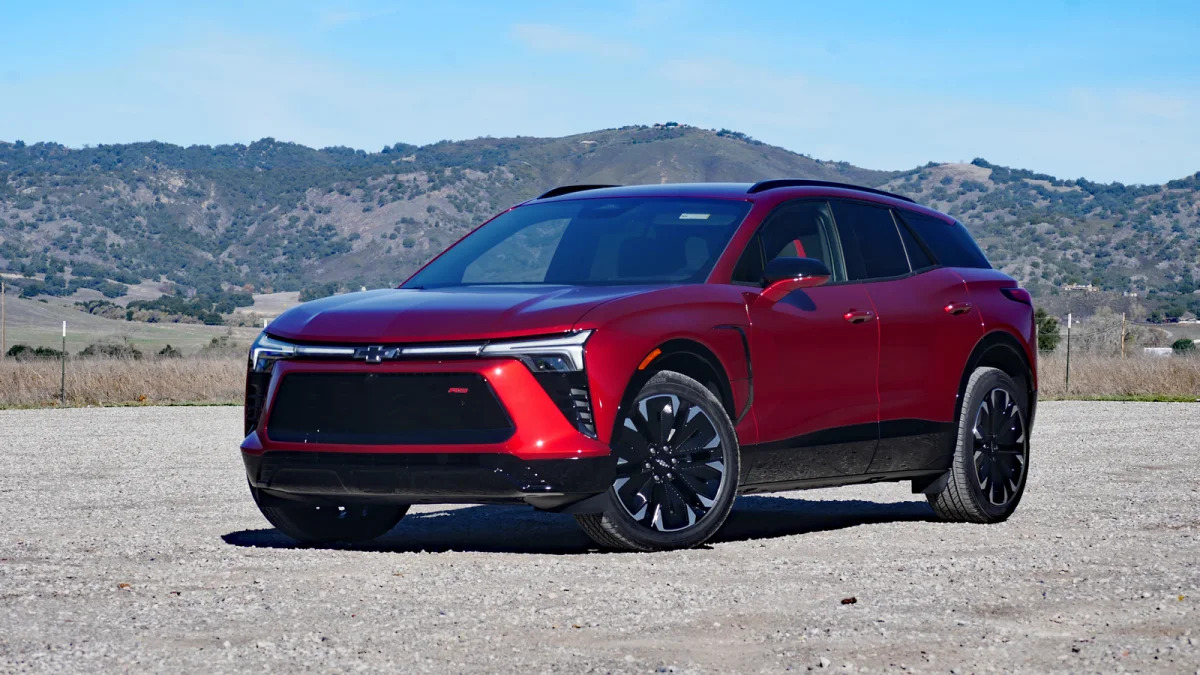










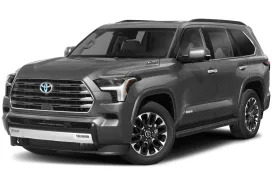

Sign in to post
Please sign in to leave a comment.
Continue